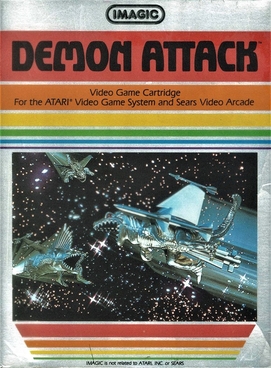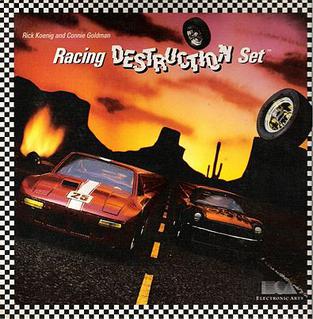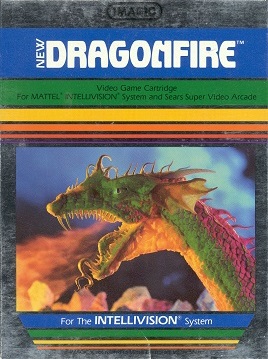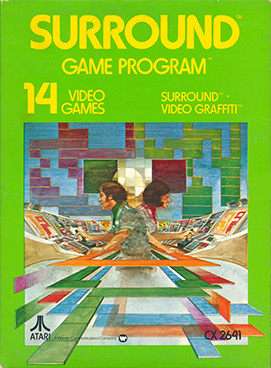
The Atari 5200 SuperSystem or simply Atari 5200 is a home video game console introduced in 1982 by Atari, Inc. as a higher-end complement for the popular Atari Video Computer System. The VCS was renamed to the Atari 2600 at the time of the 5200's launch. Created to compete with Mattel's Intellivision, the 5200 wound up a direct competitor of ColecoVision shortly after its release. While the Coleco system shipped with the first home version of Nintendo's Donkey Kong, the 5200 included the 1978 arcade game Super Breakout which had already appeared on the Atari 8-bit computers and Atari VCS in 1979 and 1981 respectively.

The Atari 7800 ProSystem, or simply the Atari 7800, is a home video game console officially released by Atari Corporation in 1986 as the successor to both the Atari 2600 and Atari 5200. It can run almost all Atari 2600 cartridges, making it one of the first consoles with backward compatibility. It shipped with a different model of joystick from the 2600-standard CX40 and Pole Position II as the pack-in game. Most of the announced titles at launch were ports of 1981–1983 arcade video games.

The Intellivision is a home video game console released by Mattel Electronics in 1979. The name is a portmanteau of "intelligent television". Development began in 1977, the same year as the launch of its main competitor, the Atari 2600. In 1984, Mattel sold its video game assets to a former Mattel Electronics executive and investors, eventually becoming INTV Corporation. Game development ran from 1978 to 1990, when the Intellivision was discontinued. From 1980 to 1983, more than 3.75 million consoles were sold. As per Intellivision Entertainment the final tally through 1990 is somewhere between 4.5 and 5 million consoles sold.

Pole Position is a racing arcade video game released by Namco in 1982. It was licensed to Atari, Inc. for US manufacture and distribution. Pole Position is considered one of the most important titles from the golden age of arcade video games. It was an evolution of Namco's earlier arcade racing electro-mechanical games, notably F-1 (1976), whose designer Sho Osugi worked on Pole Position.

Kaboom! is an action video game published in 1981 by Activision for the Atari 2600. The gameplay was based on the Atari arcade video game Avalanche (1978), with the game now involving a Mad Bomber who drops bombs instead of falling rocks. Kaboom! was programmed by Larry Kaplan with David Crane coding the graphics for the buckets and Mad Bomber. It was the last game designed by Kaplan for Activision, who left the company shortly after the release of the game. The game was later ported by Paul Wilson for the Atari 5200 system.

Centipede is a 1981 fixed shooter arcade video game developed and published by Atari, Inc. Designed by Dona Bailey and Ed Logg, it was one of the most commercially successful games from the golden age of arcade video games and one of the first with a significant female player base. The primary objective is to shoot all the segments of a centipede that winds down the playing field. An arcade sequel, Millipede, followed in 1982.
Racing games are a video game genre in which the player participates in a racing competition. They may be based on anything from real-world racing leagues to fantastical settings. They are distributed along a spectrum between more realistic racing simulations and more fantastical arcade-style racing games. Kart racing games emerged in the 1990s as a popular sub-genre of the latter. Racing games may also fall under the category of sports video games.

Demon Attack is a fixed shooter video game created by Rob Fulop for the Atari 2600 and published by Imagic in 1982. The game involves the player controlling a laser cannon from the surface of a planet, shooting winged demons that fly down and attack the player in different sets of patterns.

Atlantis is a fixed shooter video game released by Imagic in July 1982 for the Atari 2600. It was written by Dennis Koble who also wrote Trick Shot, Solar Storm, and Shootin' Gallery for Imagic. Atlantis was ported to the Atari 8-bit computers, VIC-20, Intellivision, and Magnavox Odyssey 2. The game was inspired by Taito's 1981 Colony 7 arcade game.

Racing Destruction Set is a racing video game published in 1985 for the Commodore 64 by Electronic Arts. It was advertised as being Commodore 128 compatible. A version for Atari 8-bit computers, programmed by Rebecca Heineman of Interplay, was released in 1986 in the United States, United Kingdom, and Germany. The game allows players to design and race on tracks with a variety of vehicles. It is part of the Construction Set series along with Pinball Construction Set, Music Construction Set, and Adventure Construction Set.

In the history of video games, the second-generation era refers to computer and video games, video game consoles, and handheld video game consoles available from 1976 to 1992. Notable platforms of the second generation include the Fairchild Channel F, Atari 2600, Intellivision, Odyssey 2, and ColecoVision. The generation began in November 1976 with the release of the Fairchild Channel F. This was followed by the Atari 2600 in 1977, Magnavox Odyssey² in 1978, Intellivision in 1980 and then the Emerson Arcadia 2001, ColecoVision, Atari 5200, and Vectrex, all in 1982. By the end of the era, there were over 15 different consoles. It coincided with, and was partly fuelled by, the golden age of arcade video games. This peak era of popularity and innovation for the medium resulted in many games for second generation home consoles being ports of arcade games. Space Invaders, the first "killer app" arcade game to be ported, was released in 1980 for the Atari 2600, though earlier Atari-published arcade games were ported to the 2600 previously. Coleco packaged Nintendo's Donkey Kong with the ColecoVision when it was released in August 1982.

Crossfire is a multidirectional shooter created by Jay Sullivan for the Apple II and published by On-Line Systems in 1981. Using keyboard-based twin-stick shooter controls, the player maneuvers a ship in a grid-like maze. Versions with joystick-control use the stick for movement and switch to firing mode when the button is held down.

Dragonfire is a 1982 video game written by Bob Smith and published by Imagic. The player grabs treasure guarded by a dragon while avoiding fireballs. It was originally released for the Atari 2600 then ported to the Intellivision, VIC-20, Commodore 64, Apple II, ZX Spectrum, ColecoVision, and TRS-80 Color Computer.
Micro Machines is a series of video games featuring toy cars, developed by Codemasters and published on multiple platforms. The series is based on the Micro Machines toy line of miniature vehicles.

Star Wars: The Empire Strikes Back is a scrolling shooter video game programmed by Rex Bradford for the Atari 2600 and published by Parker Brothers in 1982. It was the first licensed Star Wars video game. An Intellivision version was released in 1983.

Triple Action is an action video game produced by Mattel Electronics for its Intellivision video game system in 1981. The game actually includes three separate games—racing, tank combat and flying—where two players compete against each other for the best score.

Auto Racing is a racing video game written by Larry Zwick and released by Mattel for its Intellivision video game console in 1980. Auto Racing pits two players against each other using a top-down perspective on one of five different race courses. Auto Racing was released under the same name by Sears for its private-label version of the Intellivision console, the Super Video Arcade.

Surround is a video game programmed by Alan Miller and published by Atari, Inc. for the Atari 2600. The game plays similarly to the arcade game Blockade (1976), which allows players to navigate a continuously moving block around an enclosed space as a wall trails behind it. Every time the opposite player has their brick hit a wall, the opposing player earns a single point, with the winner being the first to collect ten points.

Micro Machines is a racing game developed by Codemasters and originally published by Camerica for the Nintendo Entertainment System in 1991. Themed around Galoob's Micro Machines toys, players race in miniaturised toy vehicles around various environments. The game is the first installment in the Micro Machines video game series.

Home Run is a 1978 sports video game developed and published by Atari, Inc. for the Atari Video Computer System. It was the first baseball-themed game released for an Atari platform. The game received mostly negative critical reception due to its unrealistic portrayal of the sport. It was one of the games used by console competitor Mattel to show the quality improvement of Intellivision sports games over the Atari VCS.



















